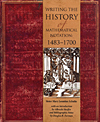- About MAA
- Membership
- MAA Publications
- Periodicals
- Blogs
- MAA Book Series
- MAA Press (an imprint of the AMS)
- MAA Notes
- MAA Reviews
- Mathematical Communication
- Information for Libraries
- Author Resources
- Advertise with MAA
- Meetings
- Competitions
- Programs
- Communities
- MAA Sections
- SIGMAA
- MAA Connect
- Students
- MAA Awards
- Awards Booklets
- Writing Awards
- Teaching Awards
- Service Awards
- Research Awards
- Lecture Awards
- Putnam Competition Individual and Team Winners
- D. E. Shaw Group AMC 8 Awards & Certificates
- Maryam Mirzakhani AMC 10 A Awards & Certificates
- Two Sigma AMC 10 B Awards & Certificates
- Jane Street AMC 12 A Awards & Certificates
- Akamai AMC 12 B Awards & Certificates
- High School Teachers
- News
You are here
Writing the History of Mathematical Notation: 1483–1700

Publisher:
Docent Press
Publication Date:
2015
Number of Pages:
240
Format:
Paperback
Price:
19.99
ISBN:
9780988744998
Category:
Monograph
[Reviewed by , on ]
Joel Haack
09/10/2015
The recent release of Sister Mary Leontius Schulte’s Writing the History of Mathematical Notation: 1483-1700, with an introduction by Albrecht Heeffer and bibliographical notes by Douglas R. Furman, is interesting for several reasons. The largest part of this book is indeed Schulte’s 1935 dissertation on the history of mathematical notation, Additions in arithmetic, 1483–1700, to the sources of Cajori’s “History of mathematical notations” and Tropfke’s “Geschichte der Elementare-Mathematik”. She identifies authors from the indicated period whose works were not cited by Florian Cajori and Johannes Tropfke (in his second edition), nor in some cases by D. E. Smith in his Rara Arithmetica, and provides summaries of how they notated arithmetic operations and procedures, extending the surveys offered in those sources. Furman has provided, in almost every case, actual reproductions of the works from 1483–1700 instead of the hand-drawn figures appearing in Schulte’s thesis.
Two biographical sketches of Schulte’s life are included. The first is a narrative written by Sister Mary Lonan Reilly, based on the Congregational Archives in Rochester, Minnesota, which included the transcript of an interview with Schulte in 1991. The second is excerpted from Judy Green and Jeanne LaDuke’s Pioneering Women in American Mathematics: The Pre-1940s PhD’s, published by the AMS.
I found Heeffer’s introductory 40-page chapter, titled “On the Historiography of Mathematical Notations,” to be of particular interest. In it, he first treats Tropfke (1866–1939), providing a short biography, a summary of the editions of Tropfke’s Geschichte and of the topics he includes, and a brief discussion of the influence his approach had on the history of mathematics. A briefer treatment of Cajori (1859–1930) and his History of Mathematical Notations follows, with a half-page biography and a page on his approach. Even though Cajori does not state that Tropfke inspired his work, he references Tropfke more than thirty times.
Heeffer then turns to an evaluation of the work in Schulte’s dissertation, citing what he sees as five problems: 1) the sources she cited are not always the most relevant ones; 2) she limited her study to the notations of basic arithmetic; 3) she ignored a more recent third edition of Tropfke’s work; 4) she assumed that there was nothing of interest before 1483; and 5) she provided no explanation for the evolution of mathematical notations. Finally, Heeffer discusses approaches to the history of mathematical symbolism, contrasting Schulte’s (and Tropfke’s and Cajori’s) internalist account with contemporary approaches, including those from semiotics, cognitive science, and historical epistemology.
I would note that the title of this book is somewhat misleading: the book does not discuss writing the history of mathematical notation between 1483 and 1700, but rather provides examples of the arithmetical notations used between 1483 and 1700 with an introduction and extended bibliographic notes.
Anyone interested in pursuing details of mathematical notation in the period 1483–1700 beyond what is presented in Cajori’s of Tropfke’s works will enjoy the examples in Schulte’s dissertation. Anyone interested in beginning to understand current scholarship in the history of mathematical notation will gain from reading Heeffer’s introduction.
Joel Haack is Professor of Mathematics at the University of Northern Iowa.
The table of contents is not available.
- Log in to post comments




